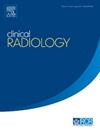Cardiac magnetic resonance imaging to predict left ventricular reverse remodelling in non-ischaemic dilated cardiomyopathy: a systematic review and meta-analysis
IF 2.1
3区 医学
Q2 RADIOLOGY, NUCLEAR MEDICINE & MEDICAL IMAGING
引用次数: 0
Abstract
AIM
This systematic review and meta-analysis aimed to evaluate the predictive value of cardiac magnetic resonance (CMR) imaging parameters for left ventricular reverse remodelling (LVRR) in patients with nonischaemic dilated cardiomyopathy (DCM).
MATERIALS AND METHODS
Electronic databases were searched for studies examining late gadolinium enhancement (LGE), native T1, and extracellular volume (ECV). A random-effect meta-analysis was conducted, with heterogeneity assessed using the I2 statistic.
RESULTS
Seventeen studies involving 1,465 participants (mean age: 54.3 years; LGE prevalence: 31%-69%) were included, with an average follow-up of 18.6 months. LGE was a strong univariate predictor of LVRR (pooled odds ratio [OR]: 3.65; 95% confidence interval [CI]: 2.45 to 5.45). A meta-analysis of three studies showed that LGE remained predictive after adjustment for baseline characteristics (pooled adjusted OR: 2.84; 95% CI: 1.50-5.37). Patients without LVRR had a greater LGE extent (weighted mean difference [MD]: 4.19%; 95% CI: 2.40%-5.97%), longer native T1 times (weighted MD: 44.84 ms; 95% CI: 25.92-63.76 ms), and higher ECV (weighted MD: 4.33%; 95% CI: 2.40%-6.26%).
CONCLUSION
The absence of LGE is a robust predictor of LVRR, even after adjustment for baseline characteristics. Patients with LVRR demonstrated lower LGE extent, shorter T1 times, and lower ECV, underscoring the utility of these CMR markers as indicators of myocardial recovery. Future research should focus on incorporating CMR parameters into clinical decision-making algorithms to enhance the management and outcomes of patients with DCM.
心脏磁共振成像预测非缺血性扩张型心肌病左心室反向重构:系统回顾和荟萃分析
目的:本系统综述和荟萃分析旨在评估心脏磁共振(CMR)成像参数对非缺血性扩张型心肌病(DCM)患者左心室反向重构(LVRR)的预测价值。材料和方法检索电子数据库,研究晚期钆增强(LGE)、原生T1和细胞外体积(ECV)。进行随机效应荟萃分析,使用I2统计量评估异质性。结果17项研究纳入1465名参与者(平均年龄:54.3岁;纳入LGE患病率:31%-69%),平均随访18.6个月。LGE是LVRR的强单因素预测因子(合并优势比[OR]: 3.65;95%置信区间[CI]: 2.45 ~ 5.45)。三项研究的荟萃分析显示,在基线特征调整后,LGE仍然具有预测性(合并调整OR: 2.84;95% ci: 1.50-5.37)。无LVRR的患者LGE程度更大(加权平均差[MD]: 4.19%;95% CI: 2.40%-5.97%),更长的原生T1时间(加权MD: 44.84 ms;95% CI: 25.92-63.76 ms)和较高的ECV(加权MD: 4.33%;95% ci: 2.40%-6.26%)。结论LGE的缺失是LVRR的可靠预测因子,即使在基线特征调整后也是如此。LVRR患者表现出较低的LGE程度、较短的T1时间和较低的ECV,强调了这些CMR标志物作为心肌恢复指标的实用性。未来的研究应侧重于将CMR参数纳入临床决策算法,以提高DCM患者的管理和预后。
本文章由计算机程序翻译,如有差异,请以英文原文为准。
求助全文
约1分钟内获得全文
求助全文
来源期刊

Clinical radiology
医学-核医学
CiteScore
4.70
自引率
3.80%
发文量
528
审稿时长
76 days
期刊介绍:
Clinical Radiology is published by Elsevier on behalf of The Royal College of Radiologists. Clinical Radiology is an International Journal bringing you original research, editorials and review articles on all aspects of diagnostic imaging, including:
• Computed tomography
• Magnetic resonance imaging
• Ultrasonography
• Digital radiology
• Interventional radiology
• Radiography
• Nuclear medicine
Papers on radiological protection, quality assurance, audit in radiology and matters relating to radiological training and education are also included. In addition, each issue contains correspondence, book reviews and notices of forthcoming events.
 求助内容:
求助内容: 应助结果提醒方式:
应助结果提醒方式:


